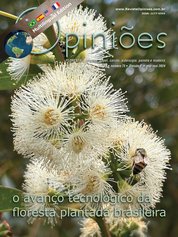Murici Carlos Candelaria e Caio Varonil de Almada Oliveira
Gerente de P&D e Melhorista de Eucalyptus da Arborgen, respectivamente
OpCP75
Inovação: o futuro das florestas plantadas
A floresta plantada brasileira vem se destacando em diferentes frentes, evidenciando ainda mais o potencial do país, não apenas em termos de recursos naturais, mas também em sua capacidade de inovação e sustentabilidade. Ao longo das últimas décadas, o setor florestal no Brasil tem recebido cada vez mais tecnologias, que antes, tinham seu foco apenas no setor agrícola.
O avanço tecnológico na floresta plantada brasileira é indiscutivelmente impulsionado por uma competição acirrada dentro do setor. A busca por eficiência e qualidade tem motivado empresas a adotarem as mais recentes inovações em suas práticas de manejo florestal. Essa competição saudável do mercado tem sido um catalisador para o rápido desenvolvimento e implementação de tecnologias de ponta. Uma das principais áreas onde esse avanço é perceptível é na silvicultura.
Graças ao uso de tecnologias como drones, GPS, sensores remotos e softwares de análise de dados, o monitoramento das florestas está cada vez mais preciso e eficiente. Esse cenário permite uma gestão mais inteligente dos recursos, identificando áreas que necessitam de intervenção específica, como o controle de pragas, e otimizando o uso de insumos, como fertilizantes e pesticidas.
Outro aspecto importante a considerar é o investimento significativo em pesquisa e desenvolvimento, com destaque para pesquisas de melhoramento genético. Universidades, instituições de pesquisa e empresas privadas estão constantemente colaborando nesse sentido.
A busca por novos materiais adaptados a diferentes condições de solo e clima, consolida o aumento de produtividade e fortalece a competitividade do setor no mercado global.
O melhoramento genético tem sido uma área de intensa pesquisa e desenvolvimento dentro do setor florestal brasileiro. Apesar dos avanços significativos, é importante reconhecer que os novos materiais genéticos nem sempre têm superado seus antecessores. Isso pode ser atribuído a uma variedade de fatores, incluindo a complexidade genética das árvores, a interação entre diferentes características, e a necessidade de testes extensivos em campo para validar o desempenho das novas variedades. Ainda assim, o investimento contínuo em pesquisa genética é crucial para enfrentar os desafios impostos pelas mudanças climáticas e garantir a sustentabilidade a longo prazo do setor florestal brasileiro.
As mudanças climáticas representam hoje, talvez o maior desafio para o melhoramento, afetando diretamente o regime de chuvas e temperatura. O aumento das temperaturas e os padrões instáveis de precipitação têm impactos significativos no crescimento e desenvolvimento das árvores, afetando a produtividade e a saúde das plantações florestais, bem como das populações de pragas e doenças da eucaliptocultura. Diante desses desafios, é fundamental que o setor florestal brasileiro adote estratégias de adaptação e mitigação para enfrentar os impactos das mudanças climáticas e garantir a resiliência das florestas diante de condições ambientais em rápida mudança.
Nos últimos anos grande quantidade de clones do gênero Eucalyptus deixaram de ser plantados em escala comercial no Brasil, por não suportarem as adversidades bióticas e abióticas que atualmente assolam a silvicultura do país. Isso sugere que apenas os genes de espécies tradicionais como E. urophylla e E. grandis, que foram utilizadas para desenvolver quase que a totalidade dos clones de eucalipto cultivados atualmente, não são suficientes para desenvolver novos clones que resistam ao desafiador cenário atual.
Em função disso, é extremamente necessário que as empresas do setor florestal possuam materiais genéticos alternativos para atender suas demandas. Recentemente várias espécies do gênero Eucalyptus têm ganhado importância para a silvicultura brasileira, como exemplo podemos citar: E. pellita, E. longirostrata, E. brassiana, E. robusta, E. dunnii, E. benthamii, E. siderophoia, E. major,
E. pilularis, E. smithii, e E. badjensis.
Isso ocorreu principalmente após instituições de pesquisa públicas e privadas divulgarem relatórios do desempenho silvicultural dessas espécies não tradicionais, evidenciando o quanto elas podem impactar positivamente o setor, se utilizadas em programas de melhoramento florestal.
A boa notícia é que muitas dessas espécies já foram domesticadas no Brasil e já existem clones híbridos compostos por algumas dessas espécies em fase final de desenvolvimento em programas de melhoramento. Podemos citar ainda outras espécies como o E. citriodora, E. torelliana, E. maculata, e E. henryi que no início de 2024 compunham o gênero Corymbia, mas que voltaram a ser classificadas como pertencentes ao gênero Eucalyptus pelos principais taxonomistas que as estudam.
Clones híbridos dessas espécies, que até recentemente eram chamados de Corymbia torelliodora já estão sendo plantados em escala comercial em algumas empresas nacionais e internacionais, para produção de celulose e carvão vegetal.
Estes clones têm se mostrado tolerantes às principais pragas e doenças que prejudicam a eucaliptocultura, além de possuírem melhor qualidade de madeira para uso nos mais distintos segmentos da atividade industrial baseada em madeira de eucalipto.
Portanto, através da exploração da diversidade genética de outras espécies não tão exploradas quanto E. urophylla e E. grandis, existem grandes oportunidades para incrementar a produtividade e tornar as florestas de eucaliptos mais resilientes às mudanças climáticas, novas pragas e doenças.




